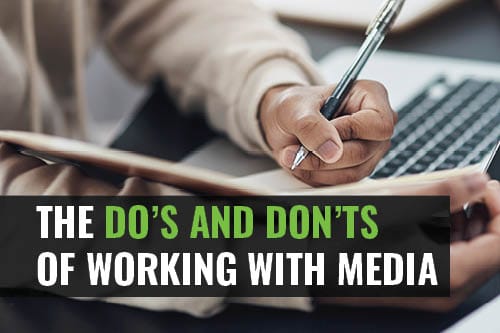The Do’s and Don’ts of Working With Media

College Basketball Hall of Fame Coach John Wooden once famously said, “Confidence comes from being prepared.” Just like Coach Wooden prepared his teams for success, media training can help prepare you to speak to the media or give a public presentation about your company. Our at-a-glance do’s and don’ts will give you the confidence to present your company in a positive and professional way in a variety of situations, from in-person, radio, phone or television interviews to small or large group presentations.
Do’s of Working With Media
- Your research. When you’re called, find out as much as you can about the media outlet or organization.
- What show or publication is this for?
- Who is the audience?
- What is your deadline?
- How much time do you need?
- What is your focus so I can make sure I have the right information or the right person there?
- For media, it’s OK to say you’ll call them back especially if you know the deadline. Take 15 minutes to gather your thoughts and/or make notes
- Talk in soundbites. Have a plan for what you want to say.
- Craft soundbites or talking points by considering your top three or four messages (answer the who, what, why, when and how questions)
- Less is more; be concise and avoid unimportant details
- Use clear-cut language geared to the audience
- Make a list of what you don’t want to say
- Avoid social slips.
- Be mindful of your audience and their social norms. What may be an acceptable phrase or viewpoint in your everyday life may have different meanings to others.
- Keep current events and the state of the world in mind. Do not mention things that are sensitive topics in your local area or in the world.
- Physical appearance is important.
- Consider what to wear … try to complement your audience yet be comfortable and professional. Avoid all black or branded clothing and for television, avoid stripes and small patterns.
- Be aware of your posture, facial expressions and body language as they often say more to the audience than your words, e.g., crossing your arms=confrontational and wringing your hands=nervous.
- Be in control. No one knows what you’re going to say except you.
- Your responses/comments steer the course of the conversation/presentation
- Smile, use eye contact and the names of the people you are speaking with
- Speak clearly and at the right volume for the interview/room
- Know and consider your audience; speak to all parts of the room
- Maintain a friendly and conversational tone and appearance
- Consider telling a story that illustrates your message; stories resonate with people
- When faced with a tough question, buy time to gather your thoughts by saying,
- “That’s a great question”
- “Can you repeat the question” or “I don’t quite understand”
- Take a drink of water or just pause
- Respond to all questions. For questions you cannot provide an answer, have a reason why prepared and explain instead of saying no comment
- Assume every word you say will be written down, quoted or repeated
- Answer in a way that can stand on its own – incorporate the question into your answer
- Be honest and as transparent as possible
- It’s OK to say “I don’t know, I’ll find out”
- Bring leave-behind materials if you have them
- Prepare for tough questions. Always expect at least one.
- Make a list of anticipated difficult questions and practice your responses
- Be empathetic to others’ perceptions and respond accordingly
- Keep your tone moderate and avoid showing anger or frustration
- Pivot back to your key messages
Don’ts of Working With Media
- Request questions in advance
- Ask to read the story, to approve it or ask for edits
- Say anything you do not want repeated
- Ask for anything to be off the record
- Ramble or go off question/topic, just answer the question and respond with your key message
- Be generic – give as detailed answers as possible
- Be too self-serving
- Provide expertise outside your knowledge or speak for others
- Be defensive or confrontational
- Discuss anything on the “do not discuss” list
- Lie
- Answer with “no comment.” Provide an explanation if you cannot answer a question. If it makes sense, say you don’t have the information right now and pivot to a key message
- Stare at cameras. You can look at the camera, but try to maintain eye contact with the individuals you are speaking with
After the interview/presentation
- Ask if there are any other questions
- Say thank you
- Use the opportunity to cultivate relationships for the next interaction
- Don’t drop your guard until you have completely left the building/situation
Whether you have done it hundreds of times or it is your first press interview, working with the media can be challenging and in some cases, intimidating. We hope you keep these tips in mind as you prepare for your next conversation with the media. If you are interested in learning more about additional public relations best practices or services for your business, contact us.

